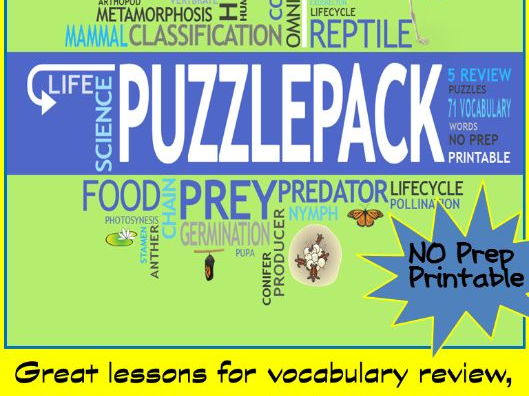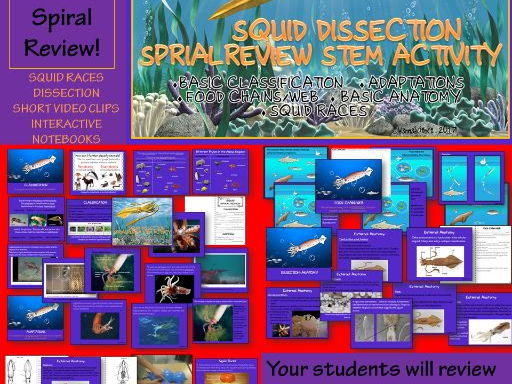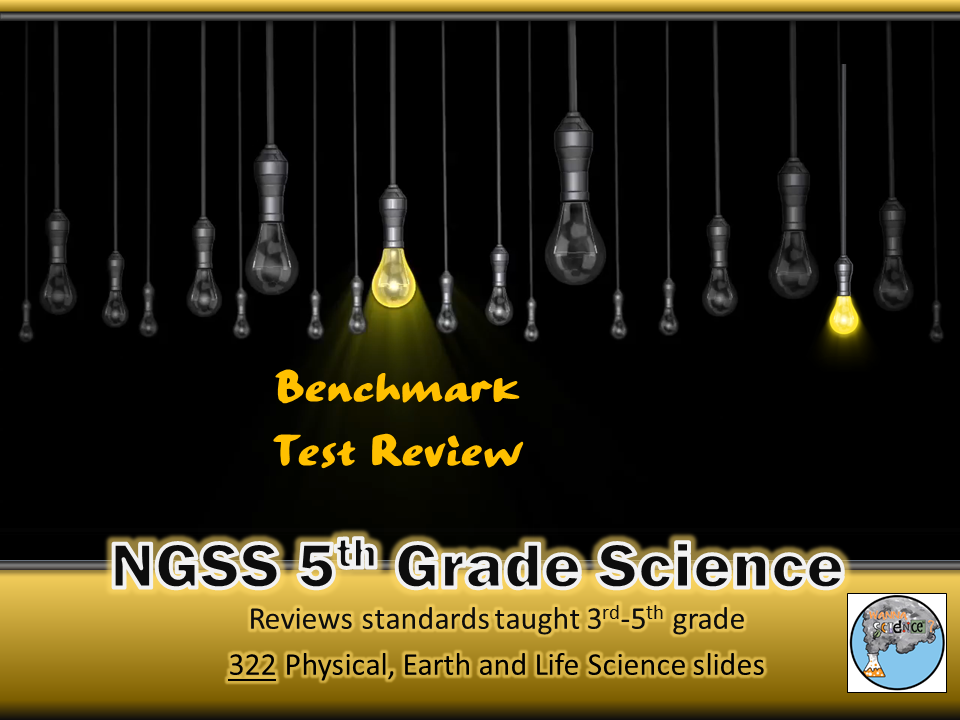
29Uploads
13k+Views
3k+Downloads
All resources

Types of Heat Transfer BUNDLE
Everything you need to meet your standards on types of heat transfer. This bundle is a complete unit, that includes all 4 products for teaching and assessing “Types of Heat Transfer: Conduction, Convection and Radiation”. Includes Lesson Power Point Presentation, Student Foldable for Interactive Science Journal, Types of Heat Transfer Popcorn Lab, and Quiz with key. You save 20% when buying the complete bundle

Interactions of Living Things PowerPoint and Interactive Student Notebook
This colorful and engaging 26 slide PowerPoint presentation lesson addresses multiple standards for the 4th and 5th grades.
After this lesson students will be able to explain that animals, including humans, cannot make their own food and that when animals eat plants or other animals, the energy stored in the food source is passed to them. They will trace the flow of energy from the Sun as it is transferred along the food chain through the producers to the consumers. Students will be able to classify consumers as herbivores, carnivores, or omnivores, and further break the groups into predator and prey. Students will also be able to construct food chains and food webs for specific ecosystems.
This lesson includes guided notes in an interactive student notebook. This bundle also includes a card sort activity in which students will first group by how they obtain energy, and then they will further break the consumers into herbivore, carnivores and omnivores, and finally they construct a food web for a saltwater marsh ecosystem. They are four embedded video clips, with specific questions pertaining to the information given during the video. As always each section is followed by a “Turn and Talk” giving your students an opportunity to discuss their newly gained knowledge.
This is a bundled lesson that includes the student interactive notes and the Power Point presentation. Student discussions (Turn and Talks) embedded in presentation. Video clips with questions and a card sorting activity. Everything you need to teach the lesson!

Life Science 5 Puzzle Review or Reinforce Bundle
NO PREP PRINTABLES! This 5 puzzle bundle works well for days you have numerous absent students, for test prep, to reinforce a lesson, or when you have a substitute teacher scheduled. As a teacher you have no missed teaching time and your students will enjoy completing the puzzles! The 5 puzzles review 71 vocabulary words from the life science units taught in 3rd through 5th grade. The puzzles cover life cycles, metamorphosis, human body, plant and flower anatomy, food chains and classification.
You will receive 5 puzzles, and 5 answer keys.
Don't want 5 puzzles, check out my individual crossword puzzles for specific units.

Squid Dissection Spiral Review STEM Activities
Are you looking for fun and engaging end of year science review activities? Squid Spiral Review STEM lesson will give your students opportunities to review vocabulary and concepts they learned earlier in the year. Your students will review Classification, Adaptations, Food Chain/Webs, and Basic Anatomy through the learning about fascinating Cephalopods! After your students have learned about cephalopods through short video clips, their interactive notebook and the PowerPoint, they will dissect a bait squid. The final project is to design their own squid to compete in “Squid Races”, while keeping in mind what they have learned about adaptations and jet propulsion. My 5th graders were very engaged and loved this lesson! I heard from both parents and teachers about how my students were talking about it out of class!
Vocabulary Reviewed:
Classification
Kingdom
Phylum
Invertebrate
Vertebrate
Class
Adaptations
Food web
Food chain
Predator
Prey
Carnivore
Herbivore
Producers
Consumers
Internal Anatomy terms- gonads, brain, heart, ink sac, gills, pen, eye lens
External Anatomy terms- mantle, eye, siphon, arms, tentacles, sucker cups, chromatophores, fin, mouth, beak
Includes step by step directions as well as photos for the squid dissection and squid races. This is a great “first” dissection because there is no blood, and you can use bait squid. The bait squid are cheap and raised on a farm for bait. Since I work at an elementary school and we do not have dissecting equipment, I barrow dissecting scissors from our high school for the day of dissection.
Some math is included in the lessons; data is collected and converted (cm, mm) and speed(distance/time) can be calculated from the squid races. Student also convert verified length of a giant squid into yards and meters to “see” how long the Giant Squid really is.
For the engineering component students design their own squid and race them to see whose design travels the farthest or is the fastest.
This is a fun and engaging thematic unit lesson that your students will talk about for years to come!

Plant Growth, Reproduction and Life Cycle Lessons with Interactive Student Notebook Lessons
This 36 slide PowerPoint equips students to identify processes of sexual reproduction in flowering plants, including pollination, fertilization, seed dispersal, and germination. Students will also identify the reproductive structures of a flower and their functions. Students will compare and contrast the major stages in the life cycles of flowering and nonflowering seed-bearing plants. The first lesson reviews how plants are classified, and then moves into flower anatomy. Flower anatomy is followed by plant reproduction, pollination and fertilization. The final two lessons are on methods of seed dispersal and plant life cycles. Included are the interactive student notes that coincide with the PowerPoint. Within the PowerPoint are EDITABLE discussion questions that can be used in group discussion, turn and talks, or as a quick assessment for understanding. Also within the PowerPoint are short relevant video clips to help reconstruct the lesson in a visual format.
As always, two versions of Student Notes are included. Use the one set for your IEP(I have them follow along and highlight the information and vocabulary words with a highlighter) or absent students.
This lesson meets the fourth grade state standards (FL-SC.4.L.16.1, SC.4.L.16.4, NGSS- LS3,LS4) , but is assessed on the annual 5th grade state benchmark exam.

What Objects are Part of the Solar System? Bundled Lesson Plans
What Objects are Part of the Solar System? This file includes a 36 slide PowerPoint to introduce your students all the components that make up the solar system. Within the PowerPoint are embedded video clips to reinforce your students learning, as well as “Turn and Talks” to get your students discussing their newly gained knowledge! This bundle includes student notes in an Interactive Science Notebook format that corresponds to the presentation. This file also includes a Solar System Review crossword puzzle to help your students review the concepts taught in this lesson. I have also included the Solar System Unit test in an editable word document so that you can add or delete any questions you think are necessary.
Also included is an editable word version of all the questions addressed during the PowerPoint presentation. This way if you decide you would rather use the questions as an exit ticket, or a quick individual assessment that is an option for you. You could also make it required that they answer the question and put them into their ISN’s. As always, I have also included answer keys to all questions, crossword and test. Your students will enjoy this engaging lesson with spectacular images about the solar system!

What are Organs and Body Systems PowerPoint and Interactive Student Notes
Keep your students fully engaged with this 36 slide PowerPoint featuring colorful 3D images accompanied by interactive student guided notes. This unit provides differentiated instruction which focuses on the Life Science Big Idea of “Organization and Development of Living Organisms”. Students will identify the organs in the human body and describe their functions. This unit includes the skin, brain, heart, lungs, stomach, liver, intestines, pancreas, muscles and skeleton, kidneys, bladder and sensory organs. Students are introduced to the body systems but most of the focus is on the organs and their functions. This PowerPoint includes probing questions that allow students to collaborate with their partners to discuss and demonstrate their newly gained knowledge. The student guided notes direct students to complete relevant information and to finalize, color, and label organ diagrams. (See photos in preview) As always, two sets of notes are included, as well as photo examples.

Science Review Board Game for Grade 5 State Benchmark Exam with 140 Game Cards
This is a test prep science review game for the annual 5th grade benchmark state assessment. The questions are based on Next Generation Science Standards for 5th grade students. This game reviews the science standards taught 3rd through 5th grade.
This game has 140 standard based question cards colored coded by area of science. It also includes 8 action cards that are science related! This game can used as review for early finishers. It can also be used to promote student centered group learning that will keep students engaged while reinforcing concepts that were taught earlier in the year or from the previous two years taught by other teachers.
THIS PRODUCT INCLUDES:
(1) 140 Color Coded Science Task Cards
+40 Life Science (blue)
+43 Physical Science (green)
+22 Space Science (purple)
+35 Earth Science (orange)
(2) Answer Cards Key
(3) 8 Action Cards
(4) Game Board
(5) Teacher Guide

NGSS 5th Grade Science Benchmark Test Prep and Game Cards
This PowerPoint contains 320 Science Grade 5 questions and answer slides. It covers NGSS PHYSICAL, EARTH and LIFE science standards that are taught throughout grades 3rd through 5th, but are tested on the 5th grade benchmark.
As a 5th grade science teacher you are responsible for content previous teachers were supposed to teach in the earlier grades. As I experienced, science in the earlier grades was overlooked because it was not tested until the 5th grade, or my students had “forgot” a lot of the content.
I use this as a review game. I have included the rules and directions for grudge ball, and have also included 32 Bazinga action cards and directions for that game as well. If you prefer not to use as a review game, this can be used for a ‘Problem of the Day’ or whole class test preparation. If I use as a Problem of the Day, I require that my students give me the correct answer, but also require that they explain why the remaining three options cannot be correct.
I have purposely broken it into each separate area of science. The PPT starts with 124 Physical Science slides, moves on to 110 Earth and Space Science slides and finishes with 84 Life Science slides. That way if you are strong in one area or didn’t get all content from another area, you can pick and choose which areas of review your students need.
I have a lot of experience with benchmark state testing. When I taught 8th grade science, I was consistently ranked the 2nd or 3rd highest public school in the state. I moved down to teach 5th grade science and after my first year, moved up 18 spots, from last place in my county!
Also in my store:
Science Test Review Game Board and 140 Game Cards









